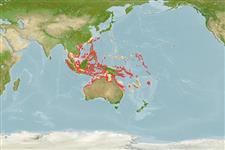Hexacorallia |
Scleractinia |
Euphylliidae
Environment: milieu / climate zone / গভীরতার পরিসীমা / distribution range
বাস্তুসংস্থান
রীফ সংশ্লিষ্ট; গভীরতার পরিসীমা 0 - 35 m (সূত্র 847). Tropical; 28°N - 31°S, 95°E - 180°E (সূত্র 847)
Indo-Pacific.
Length at first maturity / আকৃতি / Weight / Age
পরিপক্কতা : Lm ? range ? - ? cm Max length : 4.0 cm COLD পুরুষ/ লিঙ্গ অনিধর্ারিত ; (সূত্র 847)
Colonies are planeload with closely compacted corallites. Small solitary polyps are common. The primary septa are very exsert and are conspicuous underwater. No columellae. Usually pale green or gray in color with large tubular tentacles and knob-like tips.
Maximum depth from Ref. 98471. On all reef areas at depths of 1 to 35 m (Ref. 98471).
Life cycle and mating behavior
পরিপক্কতা | প্রজনন | ডিম ছাড়া | Eggs | ডিম্বধারন ক্ষমতা | Larvae
Members of the class Anthozoa are either gonochoric or hermaphroditic. Mature gametes are shed into the coelenteron and spawned through the mouth. Life cycle: The zygote develops into a planktonic planula larva. Metamorphosis begins with early morphogenesis of tentacles, septa and pharynx before larval settlement on the aboral end.
Veron, J.E.N. 2000 Corals of the world. Volume 2. Australian Institute of Marine Science and CRR Qld. Pty. Ltd. Australia. 429 p. (সূত্র 847)
IUCN Red List Status
(সূত্র 130435: Version 2025-1)
CITES status (সূত্র 108899)
Not Evaluated
Threat to humans
Human uses
| FishSource |
হাতিয়ার
আরো তথ্য
ট্রফিক বাস্তুতন্ত্র Food items (preys)
পথ্য উপাদান
খাদ্য গ্রহণ
শিকারী প্রাণী সমূহ
Population dynamicsবৃদ্ধি
Max. ages / sizes
Length-weight rel.
Length-length rel.
Length-frequencies
Mass conversion
প্রাচুর্য
Life cycleপ্রজনন পরিপক্কতা ডিম্বধারন ক্ষমতা ডিম ছাড়া EggsEgg developmentLarvae Physiologyঅম্লজান ব্যবহার
Human RelatedStamps, coins, misc.
ইন্টারনেট সুত্র
Estimates based on models
Preferred temperature
(Ref.
115969): 25.4 - 29.3, mean 28.6 (based on 2185 cells).
Fishing Vulnerability
Low vulnerability (10 of 100).
Price category
Unknown.
